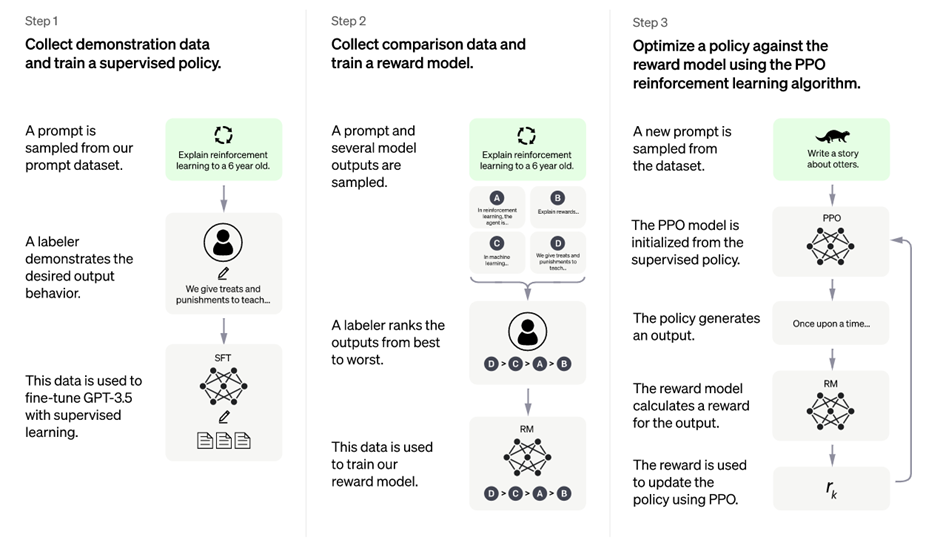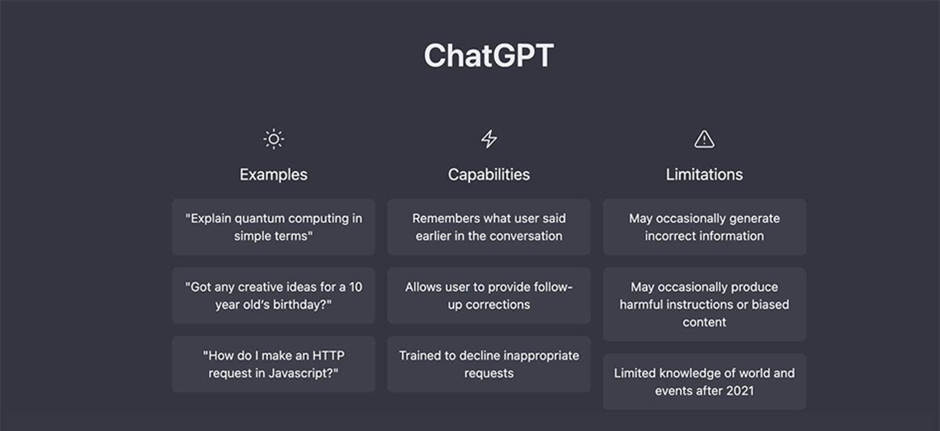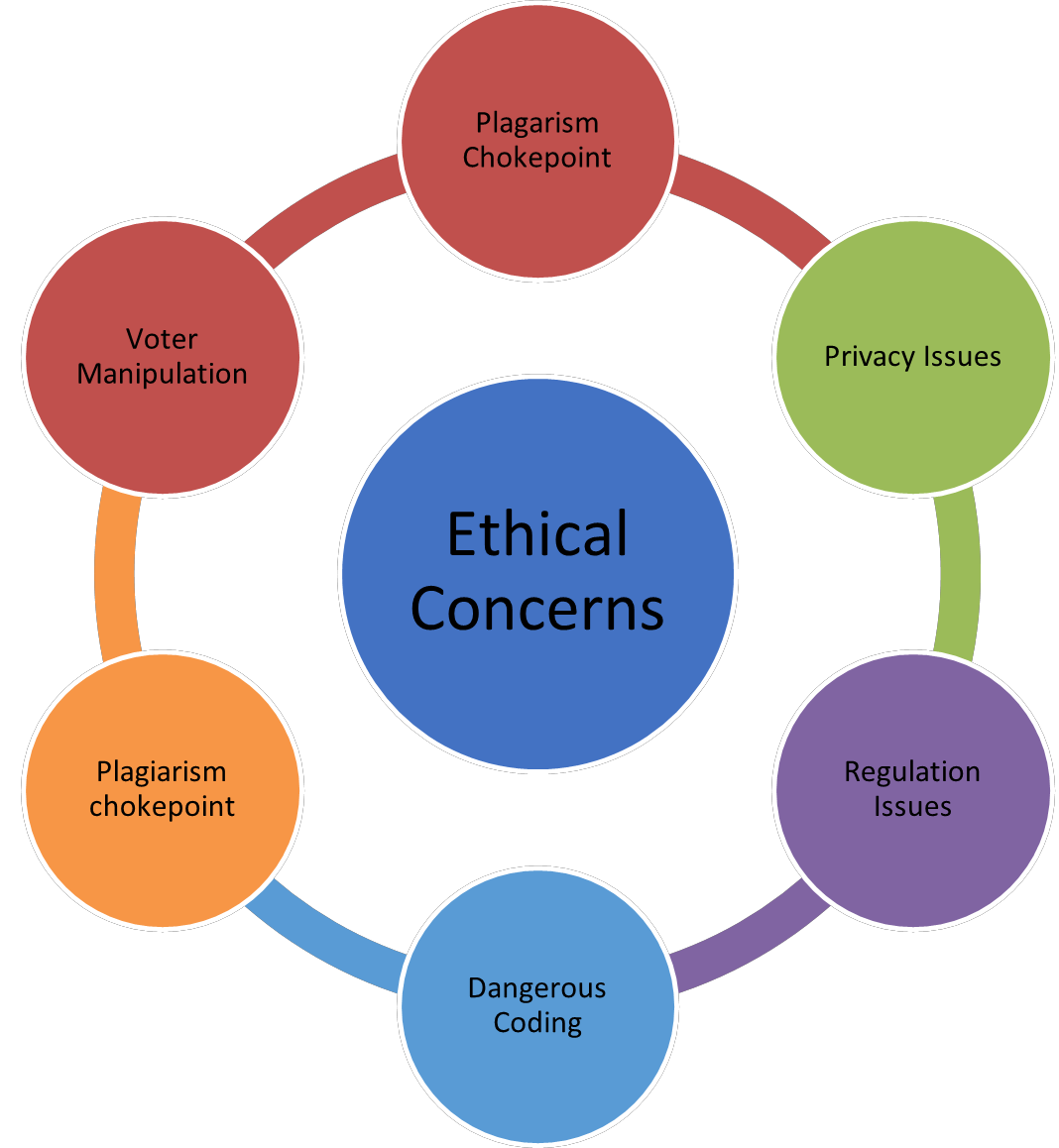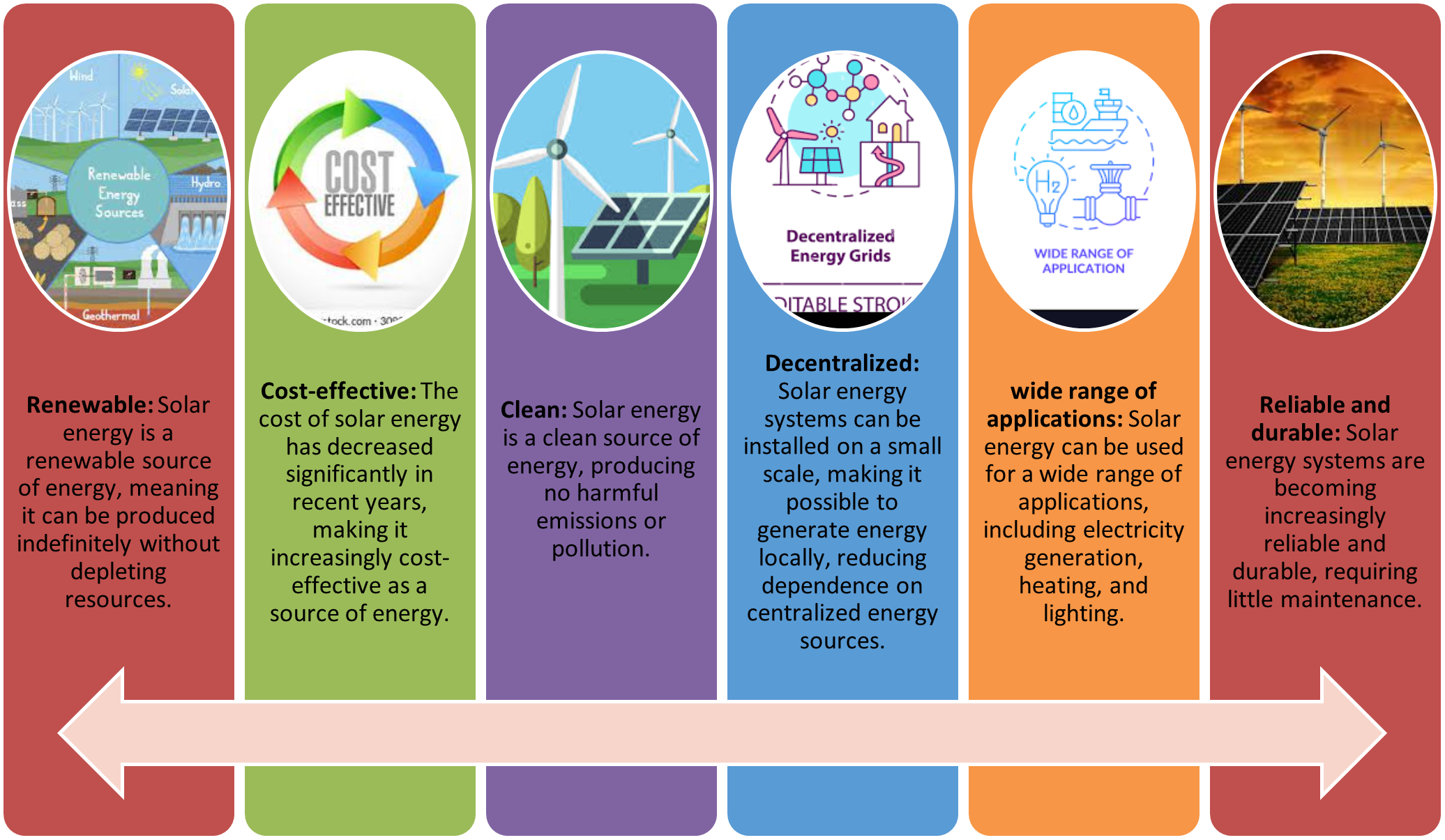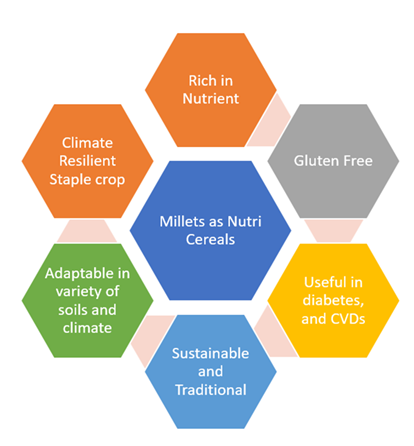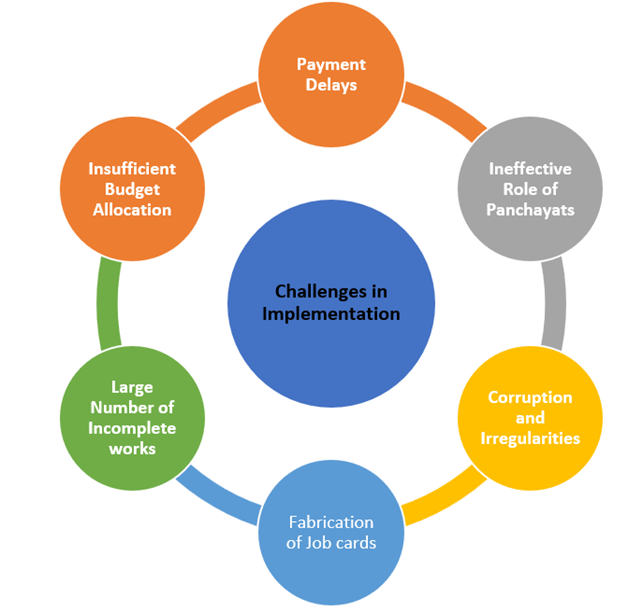Tuesday, 7th February 2023
GREEN GROWTH - Edukemy Current Affairs
In News
Budget 2023-24 announced the Mangrove Initiative for Shoreline Habitats and Tangible Incomes (MISHTI) Scheme for mangrove plantation along the coastline and on salt pan lands, Amrit Dharohar scheme for conservation of wetlands and PM-PRANAM Scheme for sustainable agriculture.
About the News:
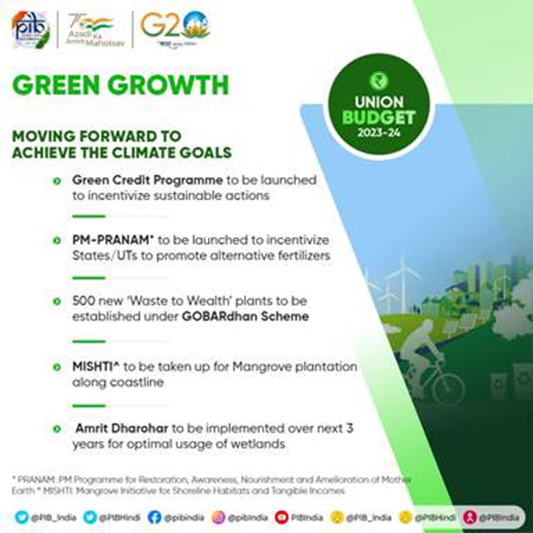
The budget 2023-23 announced important schemes:
- MISHTI Scheme: This will be implemented through the convergence of the job guarantee scheme MGNREGS, the Compensatory Afforestation Fund, and other funding sources.
- Amrit Dharohar: To promote unique conservation values in the coming three years as the total number of Ramsar sites in our country has increased to 75.
- PM-PRANAM: Promotion of Alternate Nutrients for Agriculture Management Yojana to promote chemical-free agriculture.
- Apart from this, the government announced development works in Lakshadweep and other islands.
- This has sparked a debate about “development at the cost of the environment”.
Why is the MISHTI scheme important?
Promoting mangrove plantations will –
- Provide ecological stabilization in coastal regions:
- Their dense roots bind and build soils, and the above-ground roots slow down water flow and result in sediment deposits, reducing coastal erosion
- Provide protection against cyclones:
- Mangroves prevent erosion and help stabilize coastline ecosystems as they are natural infrastructure that protects nearby populated areas by absorbing the impacts of storm surges during extreme weather events.
- Support biodiversity:
- Estuarine habitats with coastal mangrove shorelines and tree roots are often important spawning and nursery territory for juvenile marine species including prawns, crabs, and many sport and commercial fish species.
- Create blue carbon sinks:
- They capture massive amounts of Carbon dioxide emissions and other greenhouse gases from the atmosphere, and then trap and store them in their carbon-rich flooded soils for millennia.
- This buried carbon is known as “blue carbon”.
- Help improve the water quality:
- The complex mangrove root systems filter nitrates, phosphates and other pollutants from the water.
- Provide eco-tourism opportunities:
- Kayaking, snorkelling, paddle boarding etc.
- Provide income generating opportunities with eco-tourism.
Why is the Amrit Dharohar Scheme important?
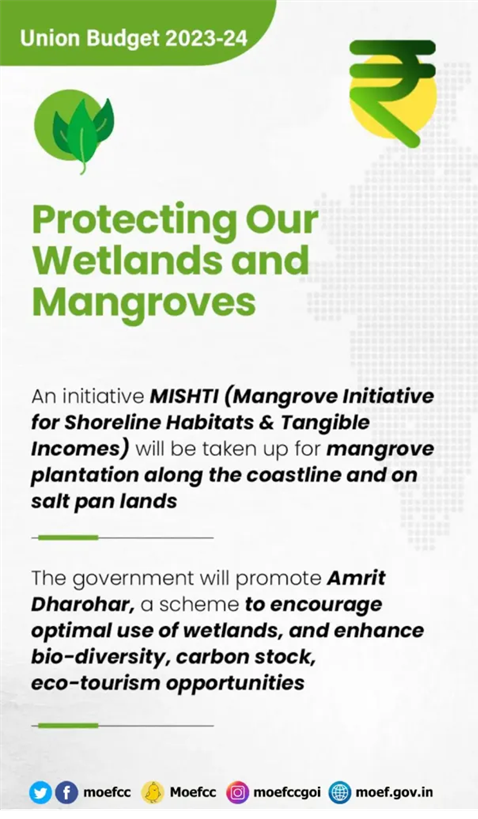
- It imbibes the Ramsar Convention’s wise use of wetlands:
- Wise use of wetland implies “the maintenance of their ecological character, achieved through the implementation of ecosystem approaches, within the context of sustainable development”.
- The scheme calls for optimal use of wetlands.
- It will stop encroachment upon wetlands and sustain biological diversity:
- Uttar Pradesh irrigation department drained out the Haiderpur wetland, a protected Ramsar site, forcing tens of thousands of migratory birds to leave.
- It will help follow Supreme Court’s orders of October, 2017:
- It directed that 201,503 wetlands mapped by the Union government should be protected under Rule 4 of the Wetlands (Conservation and Management) Rules, 2010.
- It will enable the local community to learn to respect the line between wise use and overexploitation:
- At Haiderpur wetland, some local fishing communities are over-exploiting the wetland with excessive fishing even in the protected area.
- It will help in groundwater recharge and water filtration.
What is the debate regarding the development of island territories?
- Certain mega projects have been proposed in the Budget 2023-24:
- Lakshadweep:
- High-end tourist resort facilities in the Kavaratti, Agatti, and Bangaram group of Islands.
- Positioning Lakshadweep as a prime location for scuba diving on the world map.
- Sustainable eco-tourism projects at Kadmat, Minicoy, and Suheli Islands.
- Great Nicobar:
- A township project
- International Container Transhipment Terminal (ICTT)
- These projects have struck a debate due to ethical dilemmas:
- Development vs Environment degradation
- Income and job opportunities vs destruction of natural habitats with tourism.
- Commodification of resources vs rights of indigenous tribes
- Such projects transfer ownership of resources away from the community while bringing economic returns only to the developer.
- Development vs Socio-economic destruction of the indigenous tribes
- Projects could dispossess them from their lands and livelihoods.
Source:
https://www.hindustantimes.com/india-news/fmannounces-misthi-scheme-in-union-budget-for-mangrove-plantations-101675265659103.html
CIRCULAR ECONOMY OF STEEL - Edukemy Current Affairs
In News:
At the 10th edition of the International Indian Material Recycling Conference, the Ministry of Steel declared that it will push primary steel producers to use scrapped or recycled steel as 50% of their input by 2047.
About the News:
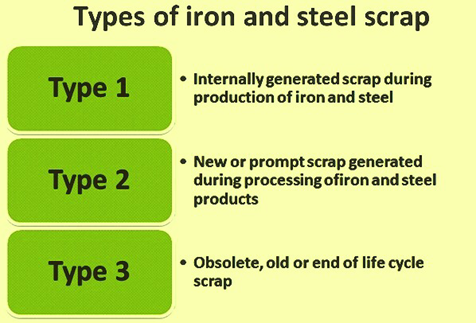 In line with the Panchamrit commitment to Net Zero by 2070, the Ministry of Steel wants to create a circular economy by pushing primary steel producers to use scrap steel and increase per capita consumption of Steel. This will help overcome:
In line with the Panchamrit commitment to Net Zero by 2070, the Ministry of Steel wants to create a circular economy by pushing primary steel producers to use scrap steel and increase per capita consumption of Steel. This will help overcome:
- The level of recycled steel usage in primary steel production is only around 10%.
- Recycled steel contributes to 22.5% of the domestic total steel production of 140 million tonnes.
- India imports 5 million tonnes of scrap steel with zero import duty despite producing 25 million tonnes of scrap steel in the last 8 years.
- Recycling industry is highly unorganized. There is a need to include the informal sector.
How will the push to primary steel producers to use scrapped steel help India?
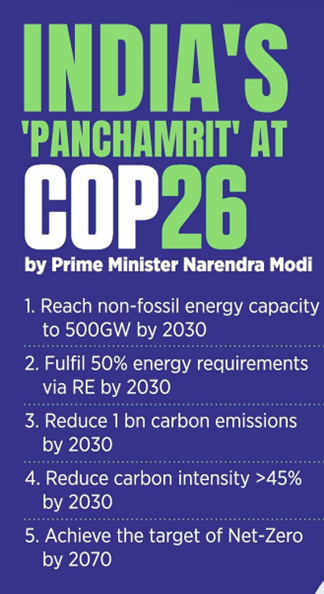
- Recycling becomes important as economies move into a circular model of development:
- Countries are discouraging exports of scraps as they move into the circular economy. Domestic recyclers used to import 25% of their shipments from the EU markets. The European Union imposed a ban on scrap exports
- Shift of focus to 6 Rs:
- Steel industry is the sub-segment of the recycling sector.
- It must be at the forefront of adaptation and mitigation by joining hands with the principle of 6 Rs which include Reduce (exploitation of natural resources), Recycle, Reuse, Recover, Re-design, and Reinforce.
- Recycling will help with the Panchamrit commitment to reducing emissions:
- Carbon dioxide emissions in the steel sector can be reduced by 5% by 2030.
- Reduced use of non-renewable resources:
- With the Vision of 2047, today's 15% of scrap usage will increase to almost 25% in the next 5 years, which means the percentage of scrap for the production of steel should go up to 50%, with only 50% being dependent on iron ore
- Formalisation and regeneration of unorganised scrap industry:
- The recycling industry is highly unorganised and is worth about USD 50 billion now. There are over 25,000 recycling units in the country.
- Contribution to economy:
- The recycling industry contributes almost 10,000 crores to India’s GST and in the years to come it is expected to go up by 35,000 crore.
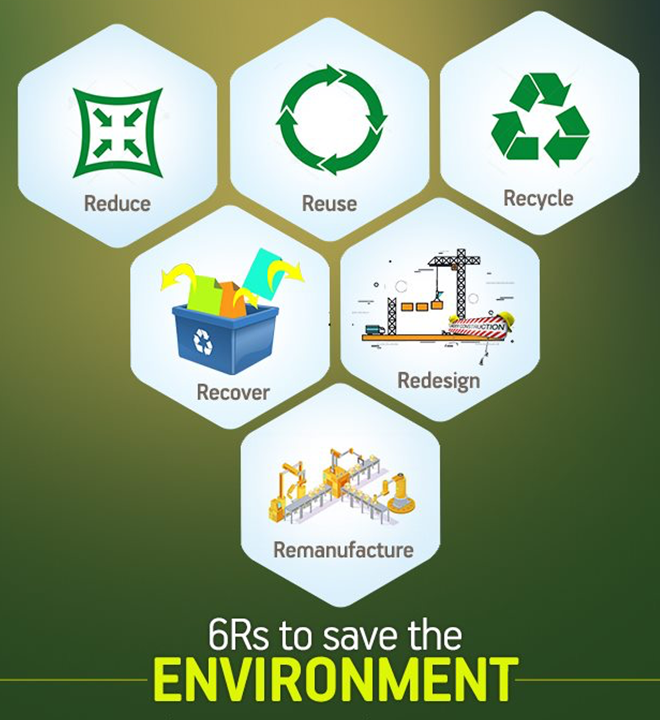
Source:
https://www.business-standard.com/article/current-affairs/govt-to-push-producers-to-use-recycled-steel-as-50-input-by-2047-scindia-123020400711_1.html
Trilateral agreement between India, UAE & France
In News:
- India joins the UAE and France for a trilateral on clean energy and pandemic prevention measures.
About the news:
- The trilateral was first discussed on the sidelines of the UN General Assembly in New York in September 2022
- A range of trilateral events will be held during India's presidency of the G20 and COP28 to be held in UAE in November-December 2023
Major highlights:
- Foreign ministers of the three countries have agreed to work together in the fields of:
- Nuclear and solar power
- Climate change and biodiversity
- Cooperation in defense preparation and counter-pandemic measures
- Trilateral will serve as a forum to promote the design and execution of cooperation projects in the fields of energy with a focus on renewable sources for climate friendly energy.
- It will develop as a consolidated group in the fight against climate change and protection of biodiversity, particularly in the Indian Ocean region(IOR)
- Countries will cooperate in multilateral organizations such as WHO, Gavi, the Global Fund.
- The three countries will also attempt to identify tangible cooperation on implementing the "One Health" approacH.
- Trilateral will also support the development of local capacities in biomedical innovation and production within developing countries.

|
Importance of France to India |
Importance of UAE to India |
|
|
https://www.thehindu.com/news/national/india-joins-uae-france-for-trilateral-on-clean-energy-and-counter-pandemic-measures/article66471623.ece
Committee Report: Protecting GIB from Power Lines
In news
- The Supreme Court constituted a 3-member committee in order to determine the technical feasibility of unground power lines for protecting Great Indian Bustard.
About
- SC in the year 2021 directed the power companies to keep low-voltage power lines underground in potential habitats of Great Indian Bustard, specifically in the Thar and Kutch deserts of Rajasthan and Gujarat.
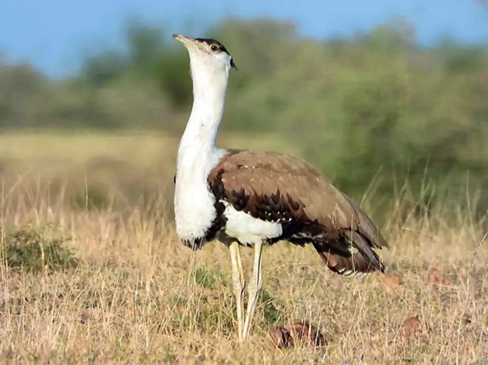
Recommendations
- Priority zones should be demarcated as the areas where birds are known to live and conservation activities can be performed.
- Bird diverters were recommended where flaps on lower power lines would work like reflectors. These flaps are visible to flying birds, reducing casualty.
However, state governments have not taken steps to comply with the SC order because:
- It is expensive and impractical to shift power lines underground
- It will increase the cost of solar power
|
Great Indian Bustard
Arid and semi-arid grasslands, thorn scrubs, and tall grasses Endemic to Indian sub-continent
Wildlife Protection Act, 1972: Schedule I CITES: Appendix I
|
https://www.thehindu.com/sci-tech/energy-and-environment/sc-committee-directs-10-of-power-lines-in-rajasthan-gujarat-be-altered-to-protect-the-great-indian-bustard/article66470168.ece/amp/
IEA Report: "Life Lessons from India"
In news
As per IEA Report India has integrated several policies in its energy transition strategy that are aligned with LiFE initiative.
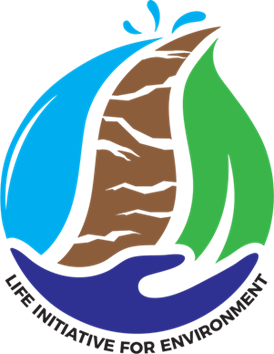
Key highlights
- Adoption of LiFE measures will result in significant reduction in annual global CO2 emissions (by 2 billion tonnes in 2030).
- LiFE measures would save consumers globally around $440 billion in 2030. India’s economy is already 10 percent more energy efficient than both global and G20 average.
- India took less time to go from half to full electricity access than other major economies.
- Around 60% of emissions saving by LiFE measures could be directly influenced or mandated by governments.
IEA
- It was created in 1974 to help co-ordinate a collective response to major disruptions in supply of oil.
- Headquarters: Paris, France.
- India is an associate member.
|
LiFE Mission ● Launched in 2021 at COP 26 ● Piloted by NITI Aayog ● Nodal Ministry: MOEFCC ● Tenure: 2022-27 Aim: ● To bring individual behaviours at forefront of global climate action narrative. ● To promote circular economy by replacing use and dispose economy ● To promote environment friendly lifestyle |
https://www.livemint.com/industry/energy/indias-life-initiative-can-save-440-bn-globally-in-2030-iea-report-11675662079012.html
Surveillance Balloon - Edukemy Current Affairs
In news
- Recently a Chinese surveillance balloon was spotted by the US in Montana.
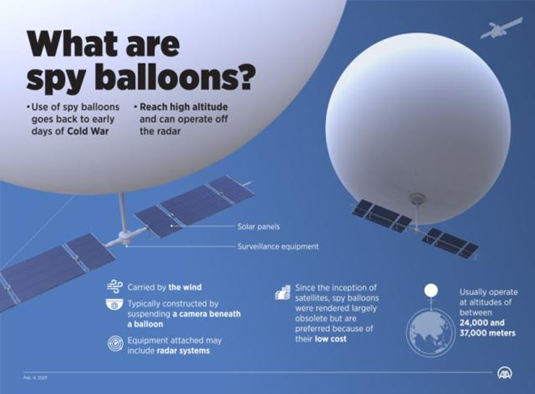
About
- Cheap, quiet and hard to reach — balloons have long been used for reconnaissance purposes, including in conflicts like the American Civil War.
- The practice became widespread during World War I and was used extensively during the Cold War, when the US launched hundreds of balloons to gather intelligence on the Soviet Union and China.
- While their use has declined with the rise of unmanned drones and satellites, many countries still employ spy balloons.
- The Pentagon is expanding investment in high-altitude inflatables.
- Modern balloons are generally unmanned, but they still generally lack propulsion and are subject to wind currents.
Uses of Surveillance Balloons
- Close range monitoring
- Improved image quality
- Gathering signals
Other types of Surveillance
- Electronic Surveillance
- Human intelligence through various officials
- Cyber espionage through cyber attacks on intellectual property
- Satellite imagery
- Unmanned Aerial Vehicles
https://www.hindustantimes.com/world-news/as-us-detects-chinese-surveillance-balloon-blinken-calls-off-beijing-visit-101675446402416.html
Universal Service Obligation Fund (USOF)
Why in news? In FY23, the government revised expenditure estimates from USOF to 3,010 crore which is 200% less than the budgetary estimate of 9,000 crores.
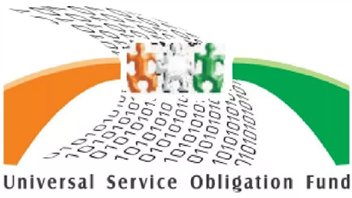
About:
- USOF is an attached office of the Department of Telecommunications (DoT), Ministry of Communications.
- It aims to provide quality and affordable mobile and digital services across rural and remote areas of the country.
- It is a non-lapsable fund, i.e., the unspent amount under a targeted financial year does not lapse and is accrued for next year’s spending.
- It was set up by an Act of Parliament in 2003 by amending Indian Telegraph Act, of 1885.
https://indianexpress.com/article/business/economy/slow-govt-spending-to-hit-connectivity-in-rural-areas-8424431/
International Maritime Organisation (IMO)
Why in news? Recently, IMO has adopted a new mandatory International Code of Safety for Ships Carrying Industrial Personnel.
About:
- Code will enter into force on 1 July 2024 and enables cargo ships and high-speed cargo craft to transport and accommodate industrial personnel working offshore.
IMO:
- IMO is a specialized agency of the United Nations that is responsible for measures to improve the safety and security of international shipping.
- Currently, it has 175 Member States (including India).
- The IMO was established following an agreement at a UN conference held in Geneva in 1948 and the IMO came into existence ten years later, meeting for the first time in 1959.
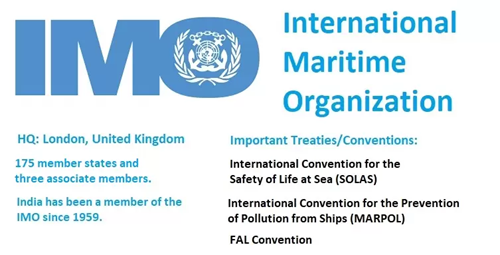
https://www.ship-technology.com/news/wartsila-tech-to-power-ferry/
Climate Tipping Points - CTPs - Edukemy Current Affairs
Why in news? ‘Teleconnections among tipping elements in the Earth system’ report highlighted that Climate tipping elements are remotely correlated, implying that there are no borders in the fight against climate change.
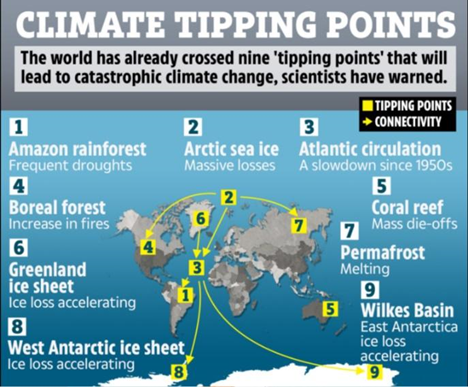
About:
- CTPs occur when changes in large parts of the climate system, known as tipping elements, become self-perpetuating beyond a warming threshold.
- These changes may lead to abrupt, irreversible, and dangerous impacts with serious implications for humanity.
- Few global tipping points identified are Greenland, the Amazon rainforest, Ocean circulation and temperature
https://www.thehindu.com/sci-tech/energy-and-environment/scientists-worried-as-study-shows-15-c-rise-can-trigger-climate-tipping-points/article65874826.ece#:~:text=Climate%20tipping%20points%20or%20CTPs,perpetuate%20warming%20on%20its%20own
Large Exposure Framework (LEF) guidelines of RBI
Why in news? Recently, the Reserve Bank of India has dismissed concerns about the “exposure” of Indian banks to the Gautam Adani-led conglomerate.
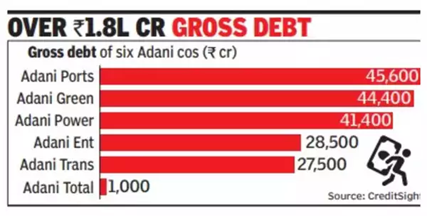
About:
- LEF is guidelines aimed to monitor and limit losses of a bank from a client or corporation.
- It is based on the 2014 Basel guidelines.
- An exception to LEF: Banks need not report exposure if the loans are taken from RBI, is guaranteed by the Government of India or have Intra-day interbank exposures or deposits are maintained by NABARD (due to shortfall in target for Priority sector Lending)
https://www.hindustantimes.com/business/adani-group-hidenburg-report-crisis-banks-stable-rbi-amid-concerns-of-exposure-to-adani-rout-101675428677450-amp.html
Global Climate Resilience Fund GCRF
Why in news? Recently, Former US secretary of state Hillary Clinton announced GCRF in partnership with the Self Employed Women’s Association (SEWA).

About:
- GCRF will work to tackle challenges faced due to rising temperatures due to climate change.
- SEWA is the single largest women worker’s Central trade union in India founded in 1972, in Ahmedabad by Elaben Bhatt.
- It has been working to improve the livelihoods of poor self-employed women workers from the informal economy through various initiatives using technology, technical training,
https://economictimes.indiatimes.com/news/international/world-news/hillary-clinton-announces-50-million-dollar-global-climate-resilience-fund/articleshow/97642067
Amorphous ice - Edukemy Current Affairs
Why in news? Recently, Scientists have created a new type of ice, called medium-density amorphous ice, that matches the density and structure of water.
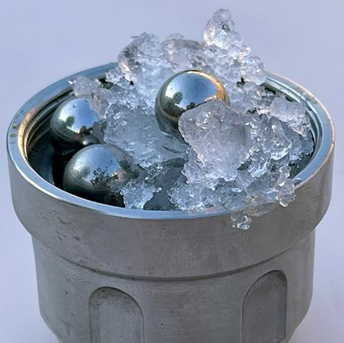
About:
- The ice was created by shaking regular ice in a small container with centimeter-wide stainless-steel balls at temperatures of -200°C to produce the novel variant.
- Normally, when water freezes, it crystallizes, and its molecules are arranged into the familiar hexagonal, solid structure - ice.
- Significance: Helps in studying water’s mysterious properties like Ice is less dense than its liquid form — an unusual property for a crystal.
- Amorphous ice consists of water molecules arranged in a disordered state, with no large-scale regularity to their orientations or positions.
- This kind of ice is most often found in space, comets, interstellar clouds,
- Almost all of the ice in natural environment of Earth (e.g., in snow, in polar caps) is crystalline ice.
https://indianexpress.com/article/explained/a-new-kind-of-ice-amorphous-solid-water-frozen-in-time-8426036/
Share the article
Get Latest Updates on Offers, Event dates, and free Mentorship sessions.

Get in touch with our Expert Academic Counsellors 👋
FAQs
UPSC Daily Current Affairs focuses on learning current events on a daily basis. An aspirant needs to study regular and updated information about current events, news, and relevant topics that are important for UPSC aspirants. It covers national and international affairs, government policies, socio-economic issues, science and technology advancements, and more.
UPSC Daily Current Affairs provides aspirants with a concise and comprehensive overview of the latest happenings and developments across various fields. It helps aspirants stay updated with current affairs and provides them with valuable insights and analysis, which are essential for answering questions in the UPSC examinations. It enhances their knowledge, analytical skills, and ability to connect current affairs with the UPSC syllabus.
UPSC Daily Current Affairs covers a wide range of topics, including politics, economics, science and technology, environment, social issues, governance, international relations, and more. It offers news summaries, in-depth analyses, editorials, opinion pieces, and relevant study materials. It also provides practice questions and quizzes to help aspirants test their understanding of current affairs.
Edukemy's UPSC Daily Current Affairs can be accessed through:
- UPSC Daily Current Affairs can be accessed through Current Affairs tab at the top of the Main Page of Edukemy.
- Edukemy Mobile app: The Daily Current Affairs can also be access through Edukemy Mobile App.
- Social media: Follow Edukemy’s official social media accounts or pages that provide UPSC Daily Current Affairs updates, including Facebook, Twitter, or Telegram channels.

